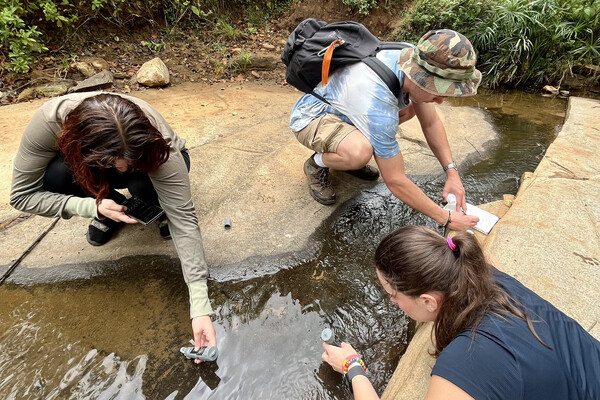
Griffin Pitt, right, works with two other student researchers to test the conductivity, total dissolved solids, salinity, and temperature of water below a sand dam in Kenya.
(Image: Courtesy of Griffin Pitt)
Religion and science are often pitted against one another. “I wanted to start a conversation that was different,” says Nicole Welk-Joerger about her article “Restoring Eden in the Anthropocene,” published in the journal Environmental Humanities. Welk-Joerger, a doctoral candidate in the Department of History and Sociology of Science, used research she’d done earlier in her academic career to lay out an approach to religion and science in regard to climate change.
The term Anthropocene refers to the idea that human activity has greatly affected the physical world. It is most frequently used today to refer to climate change, but to the Amish, she points out, Noah’s flood was an Anthropocene event, caused by humanity’s sin. While studying how farmers feed their livestock, Welk-Joerger discovered that some Amish farmers were buying a device called the Talya Water System, which claimed to return water to the state it was in before the flood. The device’s inventor advertised that the treated water would have healing qualities and would benefit the land and animals.
Though the technology was not provable, she says, “I thought it was important to take this idea seriously: the notion that Noah’s flood, in Christian understandings of the world, did affect the environment, and the Amish were adopting a technology that made sense within the Ordnung [the set of rules that guide the Amish].”
To her, farmers’ purchase of the water technology showed a willingness to take responsibility to repair the change, and to use technology to do so. “Taking another person’s point of view of livelihood and understanding of the world seriously can help open up these stories about the climate crisis.”
This story is by Susan Ahlborn. Read more at Omnia.
Penn Today Staff

Griffin Pitt, right, works with two other student researchers to test the conductivity, total dissolved solids, salinity, and temperature of water below a sand dam in Kenya.
(Image: Courtesy of Griffin Pitt)

Image: Andriy Onufriyenko via Getty Images

nocred

Provost John L. Jackson Jr.
nocred